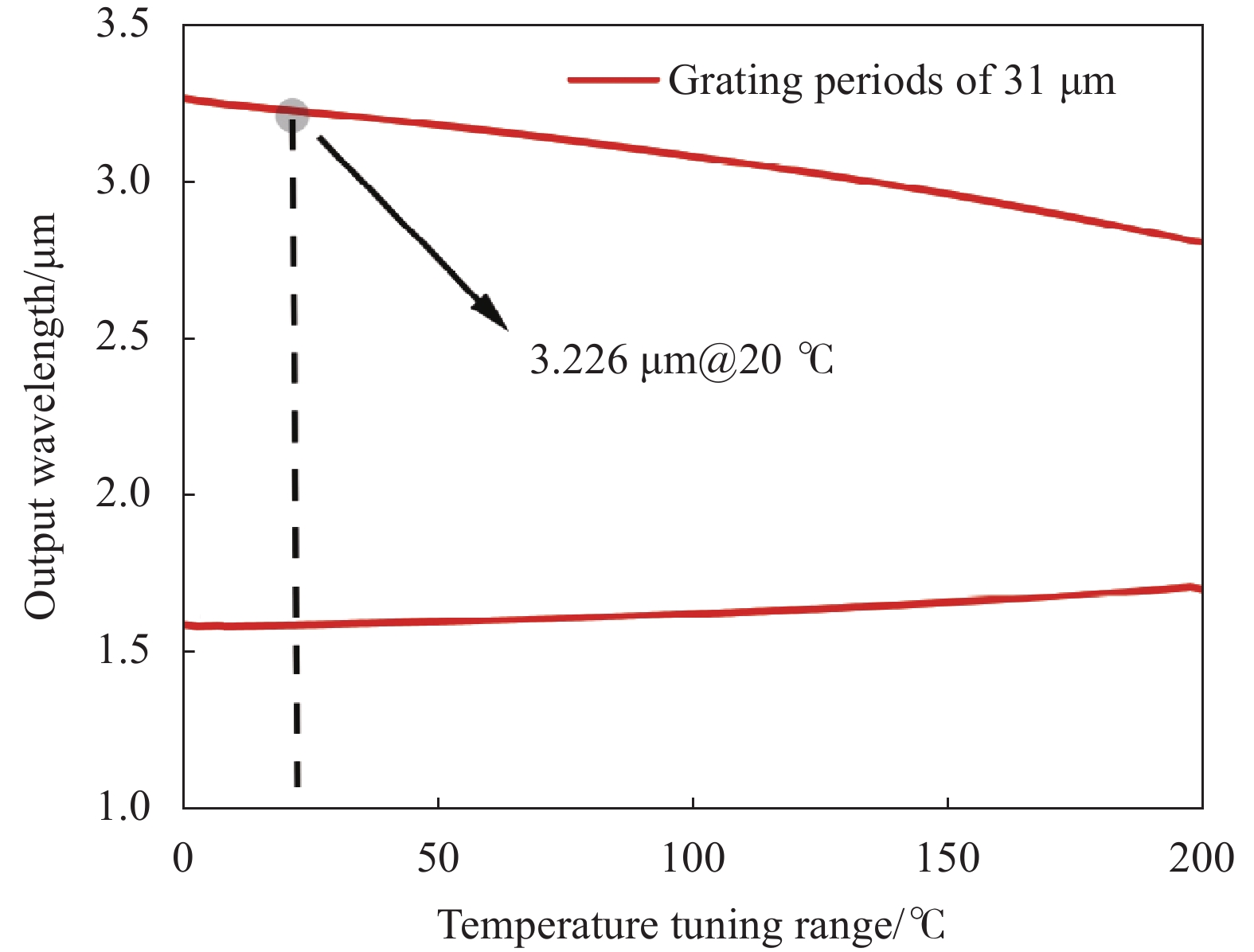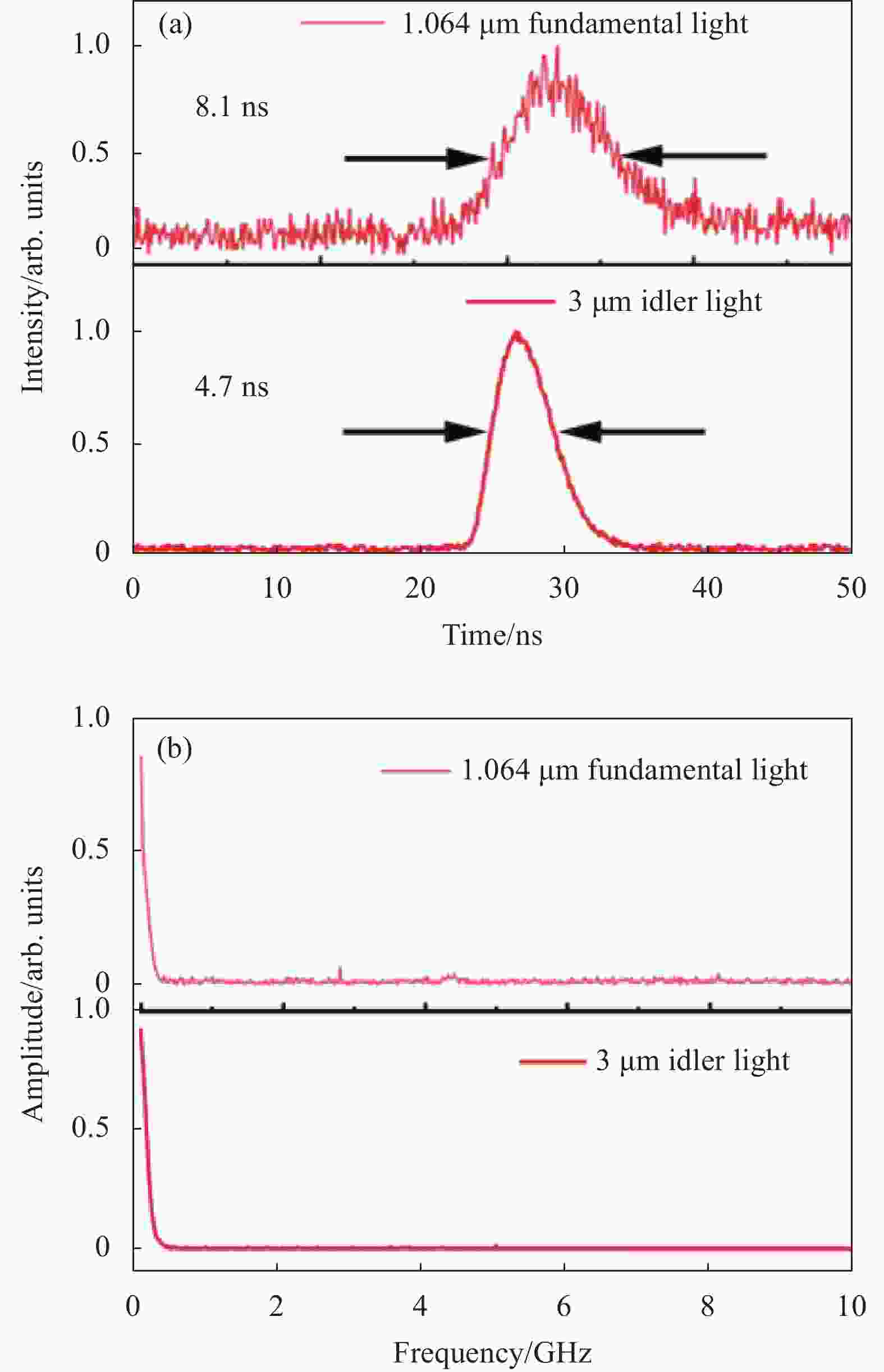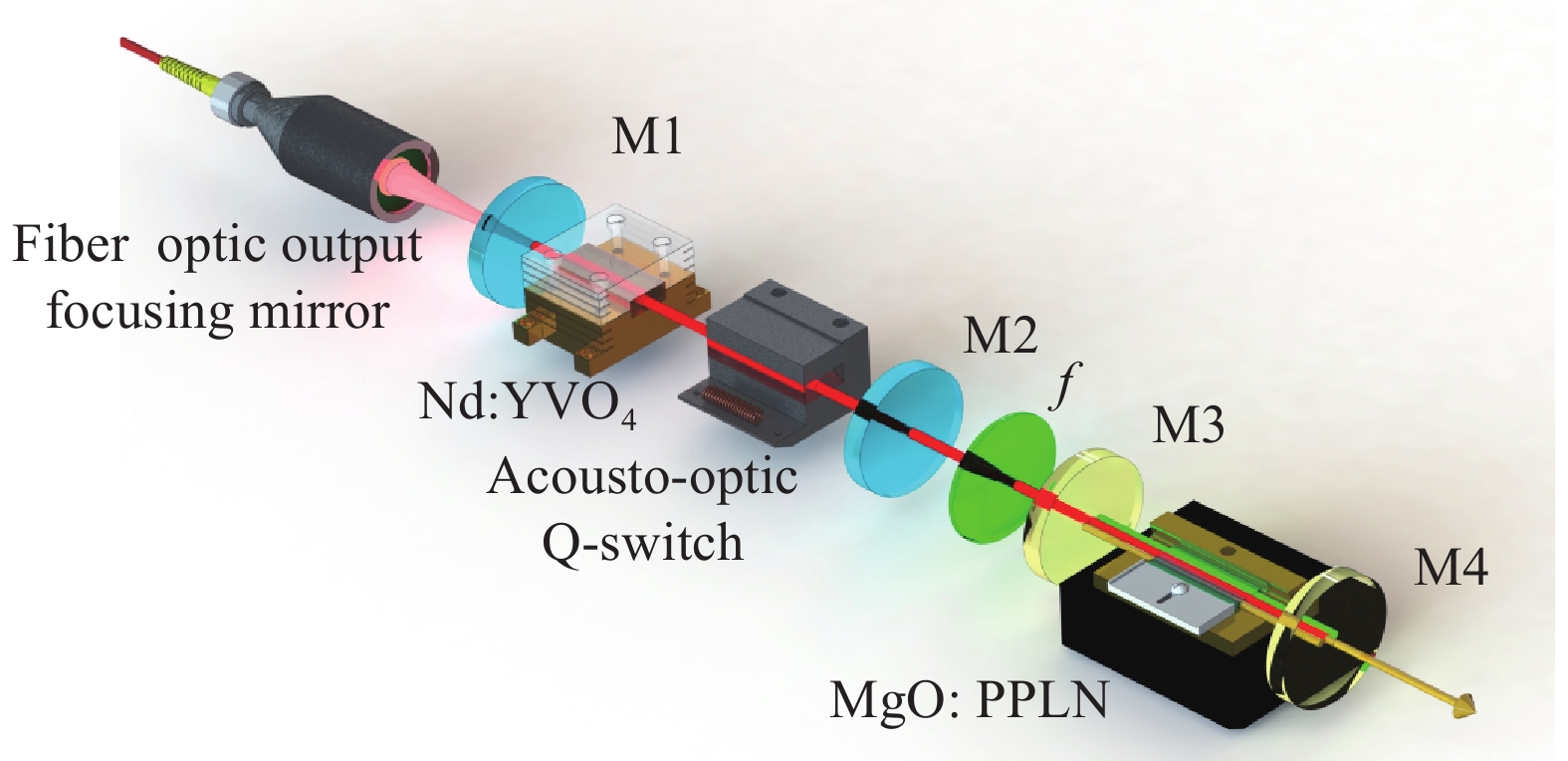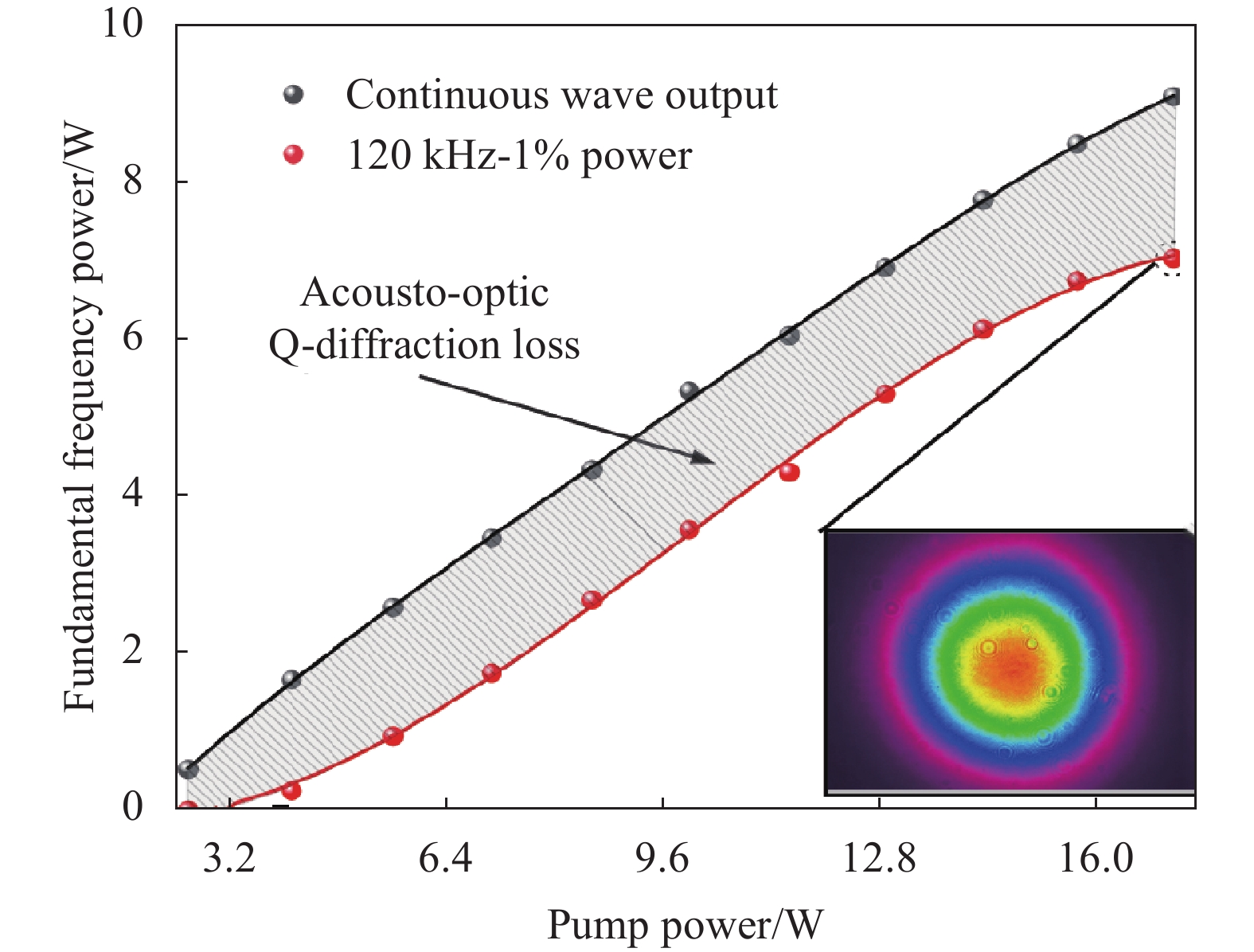-
窄线宽全固态激光器以其高相干性、低噪声和高光束质量等优点,在高精度精密测量、相干通信、光学传感、量子光学等领域有着重要应用[1-3]。而具有特定波长的窄线宽激光器是满足特定离子、分子和材料等吸收或透过的前提,因此开展不同波长和运转方式激光的纵模特性研究具有重要的实际意义[4-6]。3~5 μm中红外激光位于大气窗口,在大气中对浓雾、烟尘和灰尘有着较强的穿透性,且在海平面上的传播被气体分子吸收程度小[7-9]。同时,3~5 μm波段涵盖了大部分分子的光谱谱线,例如甲烷、乙烷、硫化氢、水蒸气等气体,因此被称为分子的“指纹谱”,是实现特殊气体监测的优质光源[10-14]。目前,3~5 μm中红外激光器已在环境气体监测、光谱分析、光电对抗等方面有着重要应用。
目前,利用激光增益介质直接产生3~5 μm中红外激光辐射的技术路线尚不成熟,因此人们往往通过非线性频率变换的方式将常规波段激光变换至3~5 μm。MgO:PPLN晶体具有高的二阶非线性系数、较高的抗损伤阈值和可实现波长调谐输出等优势,被广泛应用于光参量振荡器(OPO)中获得3~5 μm中红外激光[15-18]。
由相关报道可知,非线性光学转换过程在实现频率变换的同时也能够实现单纵模和噪声抑制[19-21]。早在1997年,英国南安普顿大学的Martin等人利用激光振荡器内二次谐波引入的损耗和色散效应,有效抑制了纵模模式跳变,实现了大范围调谐的单频激光输出[22]。2016年,澳大利亚麦考瑞大学Mildren团队利用受激散射增益介质的无空间烧孔特性,在不增加额外的模式选择元件的情况下,通过1 μm波段泵浦光实现了1.2 μm的外腔拉曼振荡器的单纵模运转[23]。2019年,该团队在腔内插入二次谐波产生元件,实现了0.6 μm可见光波段的金刚石拉曼激光的单纵模运转[24]。2023年,国科大杭州高等研究院Li等人在V型腔结构的金刚石拉曼振荡器中插入二次谐波晶体,实现了受激布里渊散射和级联拉曼散射的抑制,获得了拉曼激光的单纵模运转[25]。上述报道中可见,通过二次谐波以及三阶非线性光学效应已经实现了振荡器内纵模的有效抑制。但是针对OPO闲频光纵模的相关研究却鲜有报道。
文中以MgO:PPLN作为非线性光学频率变换晶体开展其中红外OPO中纵模特性的研究。理论模拟了MgO:PPLN-OPO输出波长随温度的调谐曲线,实验上通过声光调Q的Nd:YVO4激光器输出的多纵模1064 nm基频光泵浦MgO:PPLN-OPO,实现了少纵模和噪声抑制的3 μm闲频光输出。该研究对OPO中的纵模特性调控以及实现低噪声的参量光输出具有一定的参考价值。
-
首先,基于相位匹配公式(1)与色散方程(2),对固定周期MgO:PPLN晶体的温度调谐曲线进行计算,得到[26-27]:
式中:Λ为晶体极化周期;f(T)为以温度为自变量的函数;ai、bi为常数;nj(j=i、s、p分别为信号光、闲频光、泵浦光)为折射率;λj(j=i、s、p分别为信号光、闲频光、泵浦光)为激光波长。晶体极化周期Λ=31 μm (与后续实验采用的相一致),输出波长随温度的调谐曲线如图1所示,当环境温度为20 ℃时,闲频光的理论输出波长为3.226 μm。
实验装置如图2所示,泵浦源为808 nm的激光二极管连续激光器,通过纤芯直径400 μm,数值孔径0.22的光纤耦合输出。使用1∶2的光纤输出聚焦镜将泵浦光聚焦到Nd:YVO4晶体中,焦点处泵浦光光斑半径为400 μm,实验中使用a切Nd:YVO4晶体,尺寸为3 mm×3 mm×18 mm,掺杂浓度为0.3%。平面镜M1与M2组成1064 nm基频光谐振腔,利用声光Q开关(Gooch & Housego公司,I-QS080-1.5C10G-4-HR6)对基频光调制,腔长总长为95 mm。基频光输出后通过50 mm的聚焦镜f,将1064 nm的基频光汇聚到MgO:PPLN晶体中,基频光在焦点处的光斑半径为400 μm,MgO:PPLN晶体尺寸为10.5 mm×1 mm×20 mm,晶体掺杂浓度5%,极化周期为31.0 μm。平面镜M3与M4组成的参量光谐振腔,谐振腔长度为56 mm,最终由M4输出3 μm闲频光。实验装置中镜片的参数如表1所示。
Elements Parameters M1 AR@808 nm&HR@1064 nm plane M2 HT@1064 nm T=20% plane M3 S1:AR@1064 nm&HR@3200-4200 nm &
HR@1400-2 000 nm
S2:AR@1064 nm planeM4 S1:HR@1064 nm&HT@3200-4200 nm &
HR@1400-2 000 nm
S2:AR@3200-4200 nm planef AR@1064 nm f=50 mm Table 1. Lens parameters in experimental setup
-
1064 nm基频光的输出功率随泵浦光功率的变化,如图3所示。基频光连续最高输出功率9.1 W。在基频光腔内加入声光Q开关后,腔内衍射损耗增大,造成脉冲基频光的功率相较连续光有所降低,当重复频率为120 kHz时获得的最高输出功率降低至7.03 W。但无论是连续光还是脉冲光,输出功率并没有明显抖动或者下降趋势,未来有望通过增加泵浦光功率实现进一步提高。

Figure 3. Output power curve of 1064 nm fundamental frequency (inset: beam profile of the Q-switched output at maximum pump power)
将基频光耦合到MgO:PPLN晶体中,进行光参量振荡,输出闲频光功率随基频光功率变化如图4所示,在室温20 ℃,基频光功率为7.03 W时,获得了波长为3.196 μm (见插图),输出功率为0.702 W的闲频光,这与之前的理论预测基本一致。由于腔镜设有对信号光反射率高于90%的高反膜,因此输出的信号光较弱,测量精度要求高难度较大,并且信号光不作为文中研究重点,故不对其过多叙述。
测得的基频光与闲频光的时域波形图如图5(a)所示。基频光脉冲宽度为8.1 ns,可以看出基频光中存在多纵模,并伴随着一定程度的噪声。对应输出的3 μm闲频光的脉冲宽度为4.7 ns,相较于基频光脉冲宽度有所压窄,且波形更加平滑,这意味着相对于基频光的纵模有所抑制。为了更清晰地观察纵模和噪声的变化,将基频光和闲频光的脉冲波形图进行一次傅里叶变换,得到结果如图5(b)所示。从图中可以看出,基频光为多纵模输出且存在较为明显的噪声,而经过光参量振荡过程后,闲频光的纵模被明显的抑制了,这与时域观察到的结果相一致。
-
通过808 nm的激光二极管泵浦Nd:YVO4晶体实现了重复频率120 kHz,脉宽8.1 ns,最高7.03 W的多纵模基频光输出,泵浦光-基频光转换效率为40.9%。进行OPO实验得到了脉冲宽度为4.7 ns,输出功率0.7 W的3 μm闲频光,基频光-闲频光转换效率9.95%,将基频光与闲频光的时域波形图进行傅里叶变换后对比,可以观察到光参量振荡过程对闲频光纵模的抑制现象。该现象为OPO的纵模抑制技术提供了实验参考。
Study on the longitudinal mode characteristic of idler wave in MgO:PPLN infrared optical parametric oscillator
doi: 10.3788/IRLA20230378
- Received Date: 2023-06-20
- Rev Recd Date: 2023-08-21
- Available Online: 2023-12-22
- Publish Date: 2023-12-22
-
Key words:
- optical parametric oscillator /
- MgO:PPLN /
- longitudinal-mode /
- mid-infrared /
- idler
Abstract:














 DownLoad:
DownLoad:



